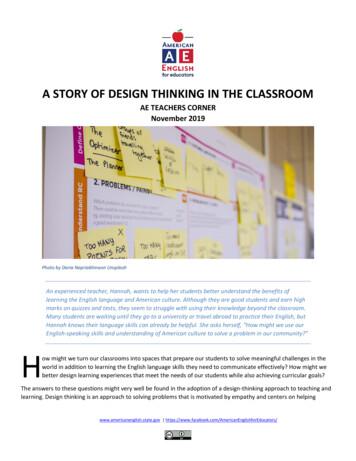Design Thinking Idealab Spring 2018
Spring 2018
DesignPrinciples ofThinkingThinking Like a DesignerFrom Idea to BusinessDan Harel, Adjunct Professor, Industrial Design, Rochester Institute of Technology, 2018 For education purposes only
Design ThinkingAn inclusive and creative methodologythat promotes user understanding andcollaborative product developmentprocess to solve problems---------But, it wasn’t always like this as userfeedback and participation was never anaim of the industrial revolution
Design ThinkingMany consumer and commercial designswell into the 20th Century displayedinsufficient consideration for user needsEarly 20th Century Household& Office equipment
Design ThinkingA user-centered approach that considersuser-understanding and user experienceas fundamental components for creatingValueA proven and repeatable process leadingto useful solutions that are inline withorganization vision or strategic intent
Design Thinking Thinking like a designerAn integrated approach to problem solvingTechnology Design ArtRational &AnalyticalIntuitive &Emotive
Design Thinking A Problem Solving MethodologyAT A GLANCE12InitialproblemdescriptionResearchBy end user,customer, ororganization User Technology Business345Design Brief &reframedproblemdefinitionIdeation & synthesisVisualization &storytellingIterativeprototypingTesting &refinementA problemworth solving Strategic directions Criteria forselecting topsolutionsFrom handsketches todetailedillustrationsCreation ofmany optionsVerify needsare met: User Technology BusinessSteps not proportionally spaced out in process diagram67
Design Thinking Product Ideation ModelBest innovation opportunitiesIdeas relating to specific user, market &technologiesRequirements BusinessCould the idea asibilityPossibilitiesCould the idea be made?Needs & DesiresCould they be identifiedand addressed?
Design Thinking Basis for Good DesignDesigners are responsible for creatingsolutions centered on the user’s experience,context, and on promoting human valuesUserNeeds & Desires ContextualEnvironment & situation needs ExperientialUser emotive needs HumanisticPromote human values
Design Thinking Selecting the Right OpportunitiesIdeasNeeds (filters)User needs & desiresBusiness requirementsTechnology possibilitiesUnfit opportunities(many)Relevant opportunities(few)ProductCommercialization
Design Thinking Initial ResearchWhat questions should be asked in theinitial research? User characteristics, needs & desiresContext/environment characteristicsBusiness viability (target market)Technology feasibility & possibilitiesCompetitive benchmarking
Design Thinking User Needs & DesiresTypical QuestionsGoals Who is the intended user(s)for my product? To become familiar with thelifestyle and relevantenvironments of the intendeduser What physical characteristicsor other attributes bestdescribe this person’s life? What are the activities thisuser is mostly involved with?Methods ObservationsInterviewsData collectionDocumentation (illustrations,photography) To identify and understandspecific problems To identify and understandspecific needs (explicit andlatent)
Design Thinking Context & Environment Interviews relating to theusage of the space: What are the characteristics of- Routine or special activitiesthe space or situation the- What works well and notproduct is intended for- Real needs and challenges(interior/exterior,- Wishes and desirescommercial/residential, social Documentation (illustrationsinteraction)and photographs)MethodsGoals Personal visit to user’s To become familiar with theenvironmentintended space the product Observation of condition andwill be operated incharacteristics To identify environmental Observation of what users doattributes that should bein this spaceconsidered in the design of theproductTypical Questions
Design Thinking Business ViabilityTypical QuestionsGoals What is the intended targetmarket for the product? To become familiar with thecohort and the market youare designing for, includingtheir lifestyle anddemographics What are the characteristicsof this market? What other markets mightalso be interested in thisproduct or its variations?Methods Market research (multiplesources) Data collection Documentation To identify specific challengesassociated with this market To identify specific needs orwants essential for businesssuccess (explicit and latent)
Design Thinking Technology FeasibilityTypical Questions What are the most importanttechnologies that should beconsidered to enable theproduct to function What are their mostimportant characteristic,benefits and downsides How easy/difficult it would beto acquire the technologies ofinterest?Methods Research and data collectionbased on the product’sfunctional needs Technical diagrams,illustrations and images Intellectual property (IP) Usage in other productsGoals To ensure functionalspecifications and estimatedproduct cost are understood To ensure the design can bemanufactured to perform asintended To identify challenges thatmight prevent a timelydevelopment (such asdeveloping new technologies)
Design Thinking Competitive BenchmarkingMethod: Evaluate & Compare Select a few consumer products from a similar product categorymade by different makers Analyze your selected products based on specific categories /questions (see previous pages)PHOTOCATEGORIES / QUESTIONSTarget marketEnvironmentTechnologyOther categories / questions ------- --------PRODUCT 1PHOTOPRODUCT 2PHOTOPRODUCT 3
Design Thinking Recommended PublicationsThinking like a designer - from idea to business Change by Design: How Design Thinking TransformsOrganizations and Inspires Innovation (Tim Brown) Design Thinking: Integrating Innovation, Customer Experience,and Brand Value (ebook) (Thomas Lockwood) The Art of Innovation: Lessons in Creativity from IDEO (TomKelley) Design Thinking for Strategic Innovation: What They Can’t TeachYou at Business or Design School (Idris Mootee) Design Thinking Process & Methods 4th Edition (Rob Curedale)
IdeaLab Team PresentationsPlease attend to the following requirementsfor your IdeaLab presentation:
IdeaLab Spring 2018 Problem area original title Problem area new title (if different) Problem statement/definition1st page of presentation shouldinclude this informationandOne image of your finalconcept design Team members information:- Full name- College/department- Year at RIT- Email contact Team advisor (client)- Name email contact Team coach (RIT faculty)- Name email contact
Project Requirement (each team) Original problem description (customerrequirements)Follow this simplified DesignThinking process to research,organize and present your conceptsolution.Use as many pages as necessary User profile/needs and desiresContext/environment characteristicsTarget market/business viabilityTechnology feasibility and possibilitiesCompetitive benchmarking Refined/reframed problem definition Brainstorming ideation and synthesis(record of all ideas) The “winning” concept solution (sketchesor CAD) and anticipated resources Experimental 3D prototypes (images) Documentation: Google doc/presentation
Design Thinking Recommended Publications Thinking like a designer - from idea to business Change by Design: How Design Thinking Transforms Organizations and Inspires Innovation (Tim Brown) Design Thinking: Integrating Innovation, Custo
people. In this article you will learn the essential qualities of a design thinking mindset, the distinctions between design thinking, design processes and designed products, and two ways to bring design thinking into your work with students. Design Thinking Vs Design Process Vs Designed Product Any Internet search for "design thinking" will .
Test Name Score Report Date March 5, 2018 thru April 1, 2018 April 20, 2018 April 2, 2018 thru April 29, 2018 May 18, 2018 April 30, 2018 thru May 27, 2018 June 15, 2018 May 28, 2018 thru June 24, 2018 July 13, 2018 June 25, 2018 thru July 22, 2018 August 10, 2018 July 23, 2018 thru August 19, 2018 September 7, 2018 August 20, 2018 thru September 1
12. LEARNING DESIGN APPROACHES FOR BUILDING DESIGN THINKING SKILLS 190 11.1 DEPLOYING DESIGN THINKING IN BUSINESS AND IN EDUCATION 190 11.1.1 Design thinking in business 190 11.1.2 Design thinking in education 191 11.1.3 Design thinking in teaching and learning through ICT 193 11.2 PROBLEM-BASED LEARNING (PBL) 193
Vive un proceso de diseño en primera persona DESIGN THINKING Curso de Design Thinking Haz Design Thinking. Sumérgete en procesos de innovación reales. . DESIGN THINKING ¿Contenidos? Diferentes lienzos y técnicas de síntesis de la información obtenida en la fase de investigación: mapa de empatía, perfil
Design Thinking work and be effective in the banking sector is an open question. DESIGN THINKING VERSUS TRADITIONAL BUSINESS THINKING We will put forward what we believe are the key differences are between Design Thinking and traditional business thinking. Broadly, these differences can be grouped into three main categories:
Critical Thinking Skills vs. Critical Thinking Disposition Critical Thinking Skills are the cognitive processes that are involved in critical thinking Critical Thinking Disposition is the attitudes, habits of mind or internal motivations that help us use critical thinking skills.
The Role of Critical Thinking in Problem Analysis Brian D. Egan, M.Sc., MBA, PMP Introduction Contrary to what the name implies, critical thinking is not thinking that is critical of others. It is “fundamental” or “vital” thinking. Critical thinking is thinking that drills down to the essence of a problem. It is introspective
be looking at him through this square, lighted window of glazed paper. As if to protect himself from her. As if to protect her. In his outstretched, protecting hand there’s the stub end of a cigarette. She retrieves the brown envelope when she’s alone, and slides the photo out from among the newspaper clippings. She lies it flat on the table and stares down into it, as if she’s peering .























